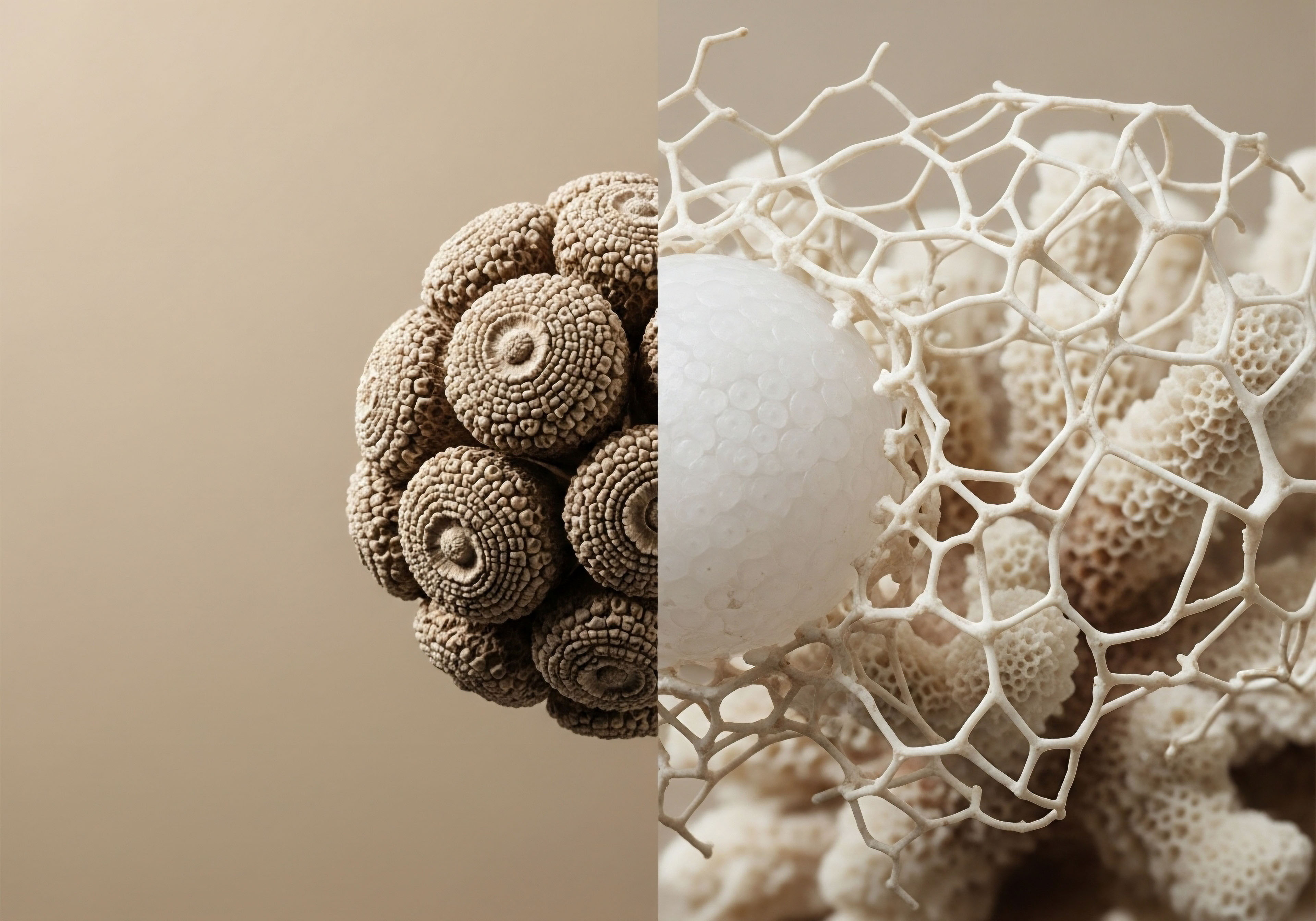

Fundamentals
Embarking on a journey of hormonal optimization is a profound act of taking control of your biological narrative. You may be seeking to reclaim the vitality, clarity, and sense of well-being that feels diminished. When fertility is also part of your life’s plan, the path forward requires a thoughtful integration of clinical support and personal agency.
It is entirely valid to ask how your daily choices can coexist with and even enhance sophisticated medical protocols. The human body is a responsive, interconnected system, and the adjustments you make to your lifestyle create the foundational environment upon which hormonal therapies can most effectively work. This is about creating a biological terrain that is receptive to both treatment and conception.
Understanding the interplay between lifestyle and fertility begins with appreciating the body’s intricate communication network ∞ the endocrine system. This system, responsible for producing and regulating hormones, is exquisitely sensitive to external inputs. Nutrition, physical activity, sleep, and stress are powerful modulators of this system.
When you are undergoing hormonal optimization, such as Testosterone Replacement Therapy (TRT), these lifestyle factors become even more significant. They can influence how your body utilizes the therapy and concurrently support the delicate hormonal cascades necessary for reproduction. The goal is to align your daily habits with your clinical objectives, creating a synergistic effect that supports both your immediate sense of wellness and your long-term family-building goals.
Lifestyle choices directly influence the hormonal environment, impacting both overall well-being and reproductive potential.

The Role of Nutrition in Hormonal Balance
The food you consume provides the essential building blocks for hormones. A diet rich in whole foods, including fruits, vegetables, lean proteins, and healthy fats, supplies the necessary nutrients for optimal endocrine function. For instance, omega-3 fatty acids, found in fatty fish and walnuts, are precursors to prostaglandins, which are involved in regulating hormone production.
Conversely, a diet high in processed foods and sugar can contribute to inflammation and insulin resistance, both of which can disrupt the sensitive hormonal balance required for regular ovulation in women and healthy sperm production in men. Maintaining a healthy weight is also a critical factor, as both underweight and overweight conditions can negatively affect fertility by altering hormone levels.
For individuals on hormonal protocols, specific dietary considerations can be beneficial. For example, adequate intake of zinc and selenium is important for sperm health, while B vitamins play a role in hormone metabolism. A balanced diet helps ensure that the body has the resources it needs to respond effectively to treatment while maintaining the intricate processes of fertility. It is about nourishing the system as a whole, providing a stable foundation for both therapeutic interventions and natural reproductive function.

Physical Activity and Its Impact on Fertility
Regular, moderate exercise is a potent tool for supporting hormonal health and fertility. Physical activity helps to improve insulin sensitivity, reduce inflammation, and manage stress, all of which contribute to a more balanced endocrine system. For both men and women, maintaining a healthy body weight through exercise is directly linked to better reproductive outcomes. In women, moderate exercise can help regulate menstrual cycles, while in men, it can improve sperm quality.
The key is moderation. Overly strenuous exercise can have the opposite effect, placing the body under physical stress that can inhibit ovulation in women or temporarily reduce sperm production in men. The aim is to find a sustainable routine that enhances well-being without creating a state of chronic stress. Activities like brisk walking, swimming, yoga, and cycling are excellent choices for promoting blood flow to the reproductive organs and supporting overall hormonal equilibrium.


Intermediate
When undergoing hormonal optimization protocols, such as Testosterone Replacement Therapy (TRT), a primary clinical consideration is the potential impact on fertility. Exogenous testosterone administration can suppress the body’s natural production of gonadotropins ∞ Luteinizing Hormone (LH) and Follicle-Stimulating Hormone (FSH) ∞ which are essential for spermatogenesis in men and ovulation in women.
This creates a need for a nuanced approach that balances the therapeutic goals of hormonal optimization with the preservation of reproductive function. Lifestyle adjustments, in this context, become a critical supportive element, helping to mitigate potential side effects and enhance the body’s overall resilience.
The Hypothalamic-Pituitary-Gonadal (HPG) axis, the central command for reproductive hormone production, is at the heart of this interplay. TRT can create a negative feedback loop that signals the hypothalamus and pituitary to reduce their output of GnRH, LH, and FSH.
However, the body’s sensitivity to these signals can be influenced by systemic factors like inflammation, oxidative stress, and metabolic health. By optimizing these factors through targeted lifestyle interventions, it is possible to create a more favorable internal environment that supports both the efficacy of the hormonal protocol and the underlying mechanisms of fertility.

Strategic Nutritional Support during Hormonal Therapy
A diet tailored to support fertility during hormonal optimization focuses on nutrient density and anti-inflammatory properties. The goal is to provide the specific cofactors required for hormone synthesis and metabolism, while also combating the oxidative stress that can damage reproductive cells.
- Antioxidant-Rich Foods ∞ Berries, leafy greens, and colorful vegetables are high in antioxidants like vitamins C and E, which help protect sperm and eggs from cellular damage.
- Healthy Fats ∞ Monounsaturated and polyunsaturated fats, found in avocados, nuts, seeds, and olive oil, are essential for hormone production and reducing inflammation.
- Lean Proteins ∞ Quality protein sources provide the amino acids necessary for the production of hormones and enzymes involved in reproductive processes.
- Complex Carbohydrates ∞ Whole grains, legumes, and starchy vegetables provide sustained energy and fiber, which helps to regulate blood sugar and insulin levels, a key aspect of hormonal balance.
For men on TRT who wish to preserve fertility, protocols often include medications like Gonadorelin or hCG to mimic LH and stimulate the testes directly. A nutrient-dense diet supports the efficacy of these adjunctive therapies by ensuring the testes have the raw materials needed for sperm production.

Exercise Prescription for Fertility and Hormonal Health
The type and intensity of exercise should be carefully calibrated to support fertility goals while on hormonal therapy. The focus is on consistency and moderation to avoid the physiological stress of overtraining.
| Exercise Type | Recommended Frequency | Benefits for Fertility |
|---|---|---|
| Moderate Aerobic Activity (e.g. brisk walking, swimming) | 3-5 times per week | Improves insulin sensitivity, enhances blood flow, reduces stress. |
| Strength Training | 2-3 times per week | Builds muscle mass, improves metabolic health, supports healthy body composition. |
| Mind-Body Practices (e.g. yoga, tai chi) | 2-3 times per week | Lowers cortisol levels, reduces stress, improves hormonal regulation. |
Calibrated exercise and targeted nutrition can create a synergistic effect, enhancing the body’s response to hormonal therapies while supporting reproductive health.

Stress Management and Sleep the Unseen Modulators
Chronic stress is a significant disruptor of the HPG axis. The release of cortisol, the body’s primary stress hormone, can directly suppress the production of reproductive hormones. High cortisol levels can interfere with ovulation in women and negatively impact sperm production in men. Therefore, implementing a robust stress management practice is a non-negotiable aspect of supporting fertility during hormonal optimization.
Effective stress reduction techniques include mindfulness meditation, deep breathing exercises, and spending time in nature. Adequate sleep is equally important, as this is when the body repairs itself and regulates hormone production. Aiming for 7-9 hours of quality sleep per night can have a profound impact on hormonal balance and overall resilience.


Academic
The intersection of lifestyle interventions and hormonal optimization protocols for fertility preservation represents a sophisticated area of clinical endocrinology. The primary challenge in this domain is mitigating the suppressive effects of exogenous hormone administration on the Hypothalamic-Pituitary-Gonadal (HPG) axis.
In men undergoing Testosterone Replacement Therapy (TRT), the administration of exogenous testosterone leads to a down-regulation of Gonadotropin-Releasing Hormone (GnRH) from the hypothalamus, which in turn suppresses the pituitary’s secretion of Luteinizing Hormone (LH) and Follicle-Stimulating Hormone (FSH). This can result in impaired spermatogenesis and testicular atrophy.
To counteract this, clinical strategies often involve the co-administration of agents like human chorionic gonadotropin (hCG), which mimics LH activity, or selective estrogen receptor modulators (SERMs) like clomiphene citrate, which can stimulate endogenous gonadotropin production. Lifestyle adjustments, from a mechanistic perspective, can be viewed as a means of optimizing the physiological environment to enhance the efficacy of these interventions and support the underlying cellular processes of gametogenesis.

Nutrigenomics and Metabolic Influences on Fertility
The field of nutrigenomics offers insights into how specific dietary components can influence gene expression related to fertility. For example, certain nutrients can modulate the activity of enzymes involved in steroidogenesis and detoxification of hormones. A diet with a low glycemic load is known to improve insulin sensitivity, which is critical because hyperinsulinemia can exacerbate hormonal imbalances, particularly in women with Polycystic Ovary Syndrome (PCOS).
In men, oxidative stress is a major contributor to sperm DNA fragmentation. Antioxidants obtained through the diet, such as lycopene, coenzyme Q10, and N-acetylcysteine, have been studied for their potential to mitigate this damage. The composition of the gut microbiome also appears to play a role, as it can influence systemic inflammation and estrogen metabolism. A diet rich in fiber and fermented foods can support a healthy gut microbiome, thereby contributing to a more favorable hormonal milieu.

What Is the Impact of Endocrine Disrupting Chemicals?
Exposure to endocrine-disrupting chemicals (EDCs) in the environment can interfere with hormonal signaling pathways. These chemicals, found in some plastics, pesticides, and personal care products, can mimic or block the action of natural hormones. Reducing exposure to EDCs is a relevant lifestyle adjustment for individuals seeking to optimize fertility.
This can involve choosing glass or stainless steel containers for food storage, opting for organic produce when possible, and selecting personal care products free from phthalates and parabens. While the individual impact of any single EDC may be small, the cumulative effect of multiple exposures can be significant.
| Intervention | Primary Mechanism of Action | Clinical Relevance for Fertility |
|---|---|---|
| Dietary Modification (low glycemic, high antioxidant) | Improves insulin sensitivity, reduces oxidative stress. | Supports oocyte quality and sperm DNA integrity. |
| Moderate Intensity Exercise | Enhances endothelial function, modulates inflammatory cytokines. | Improves blood flow to reproductive organs, balances HPA axis. |
| Stress Reduction (e.g. mindfulness) | Down-regulates the HPA axis, lowers cortisol production. | Reduces suppression of GnRH, supports regular ovulation. |
| Adequate Sleep | Regulates circadian rhythms and nocturnal hormone secretion. | Optimizes release of LH, FSH, and growth hormone. |
Lifestyle interventions can modulate the HPG axis and mitigate the suppressive effects of exogenous hormones on fertility.

Can Exercise Physiology Optimize Gamete Quality?
From a physiological standpoint, exercise can be a double-edged sword. While moderate activity is beneficial, high-intensity, prolonged exercise can increase reactive oxygen species (ROS) and elevate cortisol, both of which are detrimental to gamete quality. The optimal exercise prescription for fertility involves a balance of aerobic and resistance training that improves metabolic parameters without inducing a chronic stress state.
The practice of periodization, common in athletic training, may have applications in this context, timing higher intensity workouts with less critical phases of the reproductive cycle.
Furthermore, exercise can influence the expression of genes involved in cellular repair and mitochondrial function. Improved mitochondrial biogenesis in response to regular exercise could theoretically enhance the energy available for oocyte maturation and sperm motility. These cellular-level adaptations underscore the potential for precisely tailored physical activity to serve as a powerful adjunct to clinical fertility protocols.
- Hormonal Axis Regulation ∞ Lifestyle factors such as stress and sleep directly impact the Hypothalamic-Pituitary-Adrenal (HPA) axis, which in turn influences the HPG axis. Chronic stress can lead to elevated cortisol, which can suppress GnRH and disrupt the entire reproductive cascade.
- Metabolic Health ∞ Maintaining a healthy weight and optimal insulin sensitivity through diet and exercise is fundamental. Insulin resistance is a key factor in many cases of subfertility and can complicate the response to hormonal therapies.
- Cellular Environment ∞ Nutrition and lifestyle choices affect the cellular environment, including levels of oxidative stress and inflammation. A diet rich in antioxidants and anti-inflammatory compounds can help protect reproductive cells from damage.

References
- Sharma, R. Biedenharn, K. R. Fedor, J. M. & Agarwal, A. (2013). Lifestyle factors and reproductive health ∞ taking control of your fertility. Reproductive Biology and Endocrinology, 11 (1), 66.
- Chavarro, J. E. Rich-Edwards, J. W. Rosner, B. A. & Willett, W. C. (2009). A prospective study of dairy foods intake and anovulatory infertility. Human Reproduction, 24 (5), 1340 ∞ 1347.
- Gaskins, A. J. & Chavarro, J. E. (2018). Diet and fertility ∞ a review. American Journal of Obstetrics and Gynecology, 218 (4), 379 ∞ 389.
- Pandey, A. K. Gupta, A. Tiwari, M. Prasad, S. & Trivedi, P. (2022). Impact of stress on female reproductive health ∞ A review. Cureus, 14 (12).
- Ramasamy, R. & Scovell, J. M. (2015). Management of fertility in men undergoing testosterone replacement therapy. The Journal of urology, 193 (3), 743-747.
- Hotaling, J. M. & Pastuszak, A. W. (2016). Management of fertility in men on testosterone replacement therapy. Current sexual health reports, 8 (3), 153-157.
- Patel, A. S. Leong, J. Y. Ramos, L. & Ramasamy, R. (2016). Testosterone is a contraceptive and should not be used in men who desire fertility. The world journal of men’s health, 34 (1), 49.
- Di Guardo, F. Vloeberghs, V. & Wyns, C. (2021). The effect of lifestyle, diet, and dietary supplements on female fertility and assisted reproductive technology outcomes. Panminerva Medica, 63 (3), 324-334.
- Skoracka, K. Ratajczak, A. E. Rychter, A. M. Dobrowolska, A. & Krela-Kaźmierczak, I. (2021). Female fertility and the nutritional approach ∞ the most important aspects. Advances in Nutrition, 12 (6), 2372-2386.
- Nassan, F. L. Jensen, T. K. Priskorn, L. Halldorsson, T. I. Chavarro, J. E. & Jørgensen, N. (2018). Association of physical activity with semen quality among healthy young men. British journal of sports medicine, 52 (12), 790-795.

Reflection
The information presented here offers a framework for understanding the powerful synergy between your daily choices and your reproductive health goals. It validates the intrinsic wisdom of your body and its responsiveness to the environment you create for it. As you move forward on your path, consider which of these areas resonates most deeply with your current experience.
The journey to wellness and fertility is a personal one, and the knowledge you have gained is a tool for empowered collaboration with your clinical team. Your biology is not a fixed state; it is a dynamic process that you have the capacity to influence. What is one small, sustainable change you can make today to support your body’s intricate and remarkable systems?



